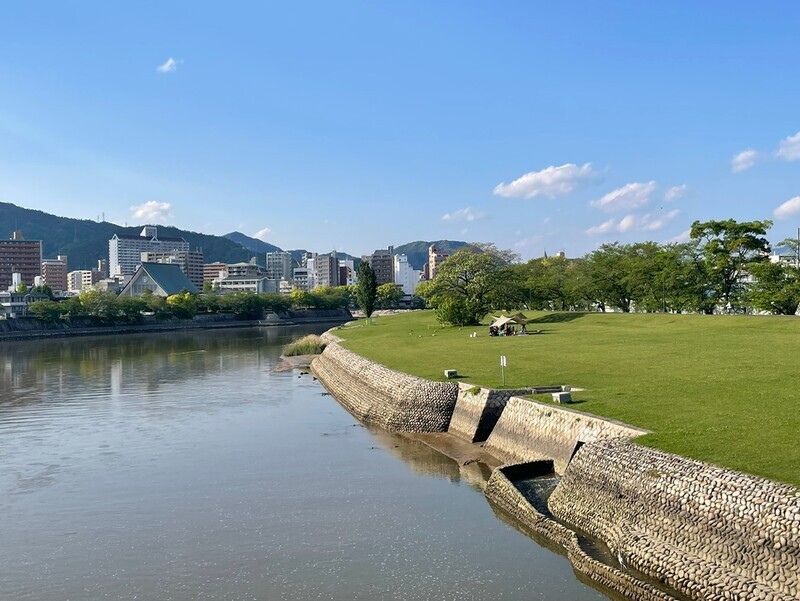hankyoreh
Links to other country sites 다른 나라 사이트 링크
[Correspondent’s column] Selective memory of atrocity makes Japan’s calls for peace ring hollow


By Kim So-youn, Tokyo correspondent
“A single bomb robbed me of everything.”
This sentence appears in a book I received on April 26 from 73-year-old Kwon Jun-o, vice chair of the atomic bomb victims special action committee at the Hiroshima office of the Korean Residents Union in Japan, better known as Mindan. Kwon is the child of people who were exposed to radiation in the US’ atomic attack on Japan 78 years ago.
At 8:15 am on Monday, Aug. 6, 1945, an American bomber dropped Little Boy — the first atomic bomb in human history — on the Japanese city of Hiroshima. The city was engulfed by an inferno that claimed the lives of 140,000 of its 350,000 residents.
It’s emotionally draining to tour the entirety of the Hiroshima Peace Memorial Museum, which displays artifacts and photographs that depict the horrors of the atomic bomb. Even after I’d left the museum, my mind lingered on the images of so many human lives snuffed out by that single bomb.
About a 30-minute walk through the streets behind the museum leads to a green lawn running alongside the waters of the Ota River. Today, the Motomachi district is a playground for Hiroshima residents, but it used to be known as the “A-bomb slum.”
Hiroshima residents who had lost everything in the atomic attack came here to rebuild their homes and begin a new life. That included Koreans with nowhere to go, who built a warren of illegal shacks along the river.
“The A-bomb slum was regarded as being poor, filthy and dangerous. It’s a distressing name that was a product of its era,” said Lee Heon-baek, 89, a survivor of the atomic bomb attack.
“There were a lot of Koreans living here. There weren’t many places back then where Korean survivors of the atomic bomb could live given the stigma and discrimination they faced,” Lee said.
Statistics show that this neighborhood was home to about one-sixth of the Korean population of Hiroshima in the mid- and late 1960s. Leaving the slum wasn’t easy despite flooding in the summer and fires in the fall.
Life wasn’t any easier for atomic bomb survivors who managed to return home to Korea. Son Jin-du (1927-2014) was caught attempting to sneak into Japan in December 1970 with the hope of getting treatment for her lingering exposure sickness. She thought that Japan owed her the quality treatment she couldn’t get in Korea.
The Japanese government passed the A-bomb Survivors Medical Care Law in 1957, but Son wasn’t afforded any care by the act, which was limited to residents of Japan. After a lengthy legal battle that was aided by Japanese civil society, Son prevailed in 1978 at the Japanese Supreme Court.
If not for their ferocious struggle, Korean atomic bomb survivors wouldn’t have been afforded anything.
Following Japan, Korea has the most atomic bomb victims in the world. It’s estimated that around 70,000 Koreans were exposed to the atomic blast in Hiroshima and Nagasaki, around 40,000 of whom were killed by its effects.
Why were those figures so high? Both cities had a cluster of munitions factories that employed large numbers of Korean labor conscripts. Atomic bomb survivors are outraged at the needless death of so many innocents who would never have been in those cities if not for Japan’s colonial rule of Korea.
For those who tour the Hiroshima Peace Memorial Museum, the Peace Memorial Park and the Atomic Bomb Dome (a bombed-out building whose skeletal remains still stand), Hiroshima’s intended message is clear: “Never forget.”
The Japanese government also intends to remind world leaders that the horrors of an atomic attack must never be repeated during the G7 summit in Hiroshima on May 19-21.
But Japan’s historical memory is too selective. Japan stresses that it’s the only country to have suffered an atomic attack, but there are few signs of any introspection or remorse about its colonial rule or invasion of Asia.
That’s why Japan’s calls for peace ring so hollow.
Please direct questions or comments to [english@hani.co.kr]

Editorial・opinion
![[Column] Season 2 of special prosecutor probe may be coming to Korea soon [Column] Season 2 of special prosecutor probe may be coming to Korea soon](https://flexible.img.hani.co.kr/flexible/normal/500/300/imgdb/original/2024/0426/3317141030699447.jpg) [Column] Season 2 of special prosecutor probe may be coming to Korea soon
[Column] Season 2 of special prosecutor probe may be coming to Korea soon![[Column] Park Geun-hye déjà vu in Yoon Suk-yeol [Column] Park Geun-hye déjà vu in Yoon Suk-yeol](https://flexible.img.hani.co.kr/flexible/normal/500/300/imgdb/original/2024/0424/651713945113788.jpg) [Column] Park Geun-hye déjà vu in Yoon Suk-yeol
[Column] Park Geun-hye déjà vu in Yoon Suk-yeol- [Editorial] New weight of N. Korea’s nuclear threats makes dialogue all the more urgent
- [Guest essay] The real reason Korea’s new right wants to dub Rhee a founding father
- [Column] ‘Choson’: Is it time we start referring to N. Korea in its own terms?
- [Editorial] Japan’s rewriting of history with Korea has gone too far
- [Column] The president’s questionable capacity for dialogue
- [Column] Are chaebol firms just pizza pies for families to divvy up as they please?
- [Column] Has Korea, too, crossed the Rubicon on China?
- [Correspondent’s column] In Japan’s alliance with US, echoes of its past alliances with UK
Most viewed articles
- 11 in 5 unwed Korean women want child-free life, study shows
- 2AI is catching up with humans at a ‘shocking’ rate
- 3[Editorial] Yoon cries wolf of political attacks amid criticism over Tokyo summit
- 4[Photo] “Comfort woman” survivor calls on president to fulfill promises
- 5“Japan’s No. 1 salesman”: Korean groups blast president’s treatment of forced laborers
- 6Yoon calls 60+ hour workweek “unreasonable,” orders revamp of policy
- 7[Editorial] Yoon’s white flag on historical disputes with Japan backfires immediately
- 8‘We must say no’: Seoul defense chief on Korean, USFK involvement in hypothetical Taiwan crisis
- 9[Special reportage- part I] Elderly prostitution at Jongmyo Park
- 10[Photo] More Sewol paintings by Hong Sung-dam